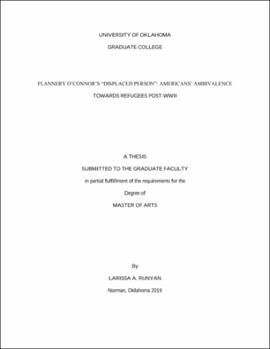| dc.description.abstract | This thesis examines how Flannery O’Connor’s novella, “The Displaced Person,” is a response to the problem of statelessness in the aftermath of World War II. During the postwar period, statelessness became a major issue. The United Nations (U.N.) sought to preserve the rights of the millions of displaced persons (D.P.s) by creating the Universal Declaration of Human Rights. However, in The Origins of Totalitarianism, Hannah Arendt critiques the legislation’s central flaw; because of the refusal to impose upon the sovereignty of individual nations, the rights the U.N. proclaims all mankind deserves have no power of implementation.
The problem of statelessness Arendt highlighted at the national level was also present in the U.S. during the postwar period. American sentiments towards the displaced were ambivalent—even xenophobic at times. This was due to a number of factors, including fears about potential Communist invaders, anti-immigrant sentiments, anxiety regarding outsiders, and American legislation. Though some government and popular publications sought to portray America as having open-arms for the stateless, the reality of Americans’ dispositions towards newcomers was often complicated. Legislation concerning displaced persons continued to be debated and continued to be impacted by the restrictive tendencies of the previous 1924 Quota Acts.
In this divisive arena of sentiments, Flannery O’Connor’s novella, “The Displaced Person” (1955) offers the dilemma of “the D.P. problem.” O’Connor breaks with her typical crafting of unpleasant, ugly-hearted characters, creating refugee Guizac as an outstanding worker of integrity, resourcefulness, and mechanical prowess. Despite his character, the farm’s other inhabitants will his destruction by the story’s conclusion, watching him as he is helplessly crushed by a rogue tractor and refusing to save him. Fellow worker Mrs. Shortley fears Guizac will make her and her family placeless, exhibiting a fear of the economic and social impacts of a new worker. However, Guizac is ultimately “murdered” because of the U.S.’s pre-existent racist marital codes, which Guizac trespasses in an effort to save his cousin from the D.P. camps. Arendt comments that these marital laws should be the first target of the Civil Rights Movement, arguing that marriage is a fundamental right of all individuals regardless of race. O’Connor’s depiction of the lack of rights for both the stateless and African Americans thus pairs with Arendt’s separate critiques and answers the narrative’s implicit question. Guizac is essentially martyred at the story’s end in the sense that his death points to the problems of postwar Americans not upholding equal rights for all individuals, and the U.N. refusing to impinge upon national sovereignty. | en_US |

